Introduction
This 12-week Grow Scenario is presented in a week-by-week format so that it is easy to follow. Once seedlings are potted up into a 4-inch (55 cl) container, well-rooted and growing aboveground, they are ready to move into the vegetative grow room and start the 12-week Grow Scenario.
A maintenance schedule is included to help you stay on track and avoid common problems. The schedule will give you a base starting point so that you can finetune your garden to fit your specific needs.
See chapter Five, Grow Room Setup, for complete information on setting up lights, fans, water, nutrients and substrate so that they are most efficient.
Garden Calendar
Seedlings
| Important Dates | Date |
| Start germination | |
| Emersion | |
| Stage end | |
| Transplant |
Container, Hydroponic & Reservoir Gardens
| Growth Stage | Light Level |
| Seedling | 250 μmols/m2/second |
| Photoperiod Vegetative | 500 μmols/m2/second |
| Auto Vegetative | 300 μmols/m2/second |
| Photoperiod Flowering | 500-1000 μmols/m2/second |
| Auto-flowering | 550μmols/m2/second |
| Air | Day | Night |
| Air – Temp Range | ||
| Air – Humid Range | ||
| Air Circulation (1-10 scale) | ||
| Air Ventilation (1-10 scale) | ||
| CO2 Level (PPM) |
| Water Application/Hand/Automattic | Day | Week |
| Water Dose (gallons/liters) | ||
| Frequency (daily/weekly) |
| Fertilizer | Daily | Weekly |
| Dose (ml/L) | ||
| Frequency (day/week) | ||
| Additive (ml/L) | ||
| Frequency (day/week) | ||
| pH – Reservoirs | ||
| pH – Substrate | ||
| pH – Runoff | ||
| PPM/EC – Reservoirs | ||
| PPM/EC – Substrate | ||
| PPM/EC – Runoff |
| Substrate | Daily | Weekly |
| pH | ||
| Temperature | ||
| Container Temperature | ||
| Temperature Alarm (degrees) | ||
| Moisture 1-10 |
| Troubleshooting | Daily | Weekly |
| Inspect – culture | ||
| Inspect – Nutrient Def/Excess | ||
| Inspect – Disease & Pest | ||
| Preventive Apply AACT |
Seedlings get off to a slow start, but once established, growth is very rapid.
12-week Cannabis Garden Schedule
Transplant clones or seedlings in 1-pint (55 cl) 4-inch pots into the room. Plants should be about 4–6 inches (10–15 cm) tall. Grow seedlings that will be transplanted outdoors for a few weeks indoors before moving outdoors.
Week One: First Week of Vegetative Growth

Light
Photoperiod: 18 hours day, 6 hours night
Intensity: 250 μmols/m2/second
Auto-flower: 20 hours day, 4 hours night
Intensity: 300 μmols/m2/second
Air
Temperature
Min/Max: 55-80ºF (13-27ºC)
Ideal: 75ºF (24ºC)
Humidity
Min/Max: 50-70%
Ideal: 60%
CO2: 1,000ppm
Water:
pH: 5.5-6.5
EC: <50
Irrigation:
Keep growing medium evenly moist so that roots stay wet but still have enough air to take in nutrients. Be very careful not to overwater the limited number of roots or let tender roots dry out. Irrigate with enough water so that 10%–20% flows out the bottom of the container. Do not let plants sit in standing water. Do: Keep growing medium evenly moist. Don’t: Overwater and make soggy substrate.
Nutrients
EC: 1.4-1.8 / PPM 1,400-1,800 Use your favorite “grow” nutrients for seedlings and use as per manufacturer’s instructions. Use any additives suggested by the manufacturer. See feeding chart from manufacturer.
Soil/Substrate
pH
Soil: 6.0–6.5
Hydroponics: 5.5

Strong root systems.
Growth Characteristics:
During the first week of vegetative growth, plants develop a strong root system. You will see signs of upward green growth too. Now it is very important to keep plants from suffering water and temperature stress.

Green growth aboveground should be strong and resilient.
Week Two: Second Week of Vegetative Growth

Light
Photoperiod: 18 hours day, 6 hours night
Intensity: 500 μmols/m2/second
Auto-flower: 20 hours day, 4 hours night
Intensity: 500 μmols/m2/second
Air
Temperature
Min/Max: 55-80ºF (13-27ºC)
Ideal: 75ºF (24ºC)
Humidity
Min/Max: 50-70%
Ideal: 60%
CO2: 1,000ppm
Water:
pH: 5.5-6.5
EC: <50 ppm
Irrigation: Plants need a little more water now. Keep growing medium evenly moist. Be very careful not to overwater or let tender roots dry out. Plants need a little more water now.
Nutrients
EC: 1.4-1.8 / PPM 1,400-1,800
Fertilizer: Use your favorite “grow” nutrients with higher levels of nitrogen for green growth as per instructions.
Soil/Substrate
pH:
Soil: 6.0–6.5
Hydroponics: 5.5

Growth Characteristics: During the second week of vegetative growth plants plants should be about 6–8 inches (15–20 cm) tall. They will continue to develop strong root systems, and green leafy growth increases notably. Now it is very important to keep plants from suffering water and temperature stress.
Week Three: Third Week of Vegetative Growth

If you are moving photoperiod seedlings into a greenhouse or outdoors, simply extend the vegetative growth period. You can also keep seedlings in the vegetative growth stage longer so that they are bigger when you induce flowering with a 12/12 day/night light schedule.
If photoperiod seedlings are not big enough (10-12 inches (25-30 cm)) to induce flowering now, wait until they are a bit bigger. Many growers wait until seedlings are 20-24 inches (50-60 cm) tall.
If light does not penetrate foliage, and bottom leaves yellow as plants grow taller, remove them. Remove the bottom pair of leaves especially if they show signs of weak growth.
Light
Photoperiod: 18 hours day, 6 hours night
Intensity: 500 μmols/m2/second
Auto-flower: 20 hours day, 4 hours night
Intensity: 500 μmols/m2/second
Air
Temperature
Min/Max: 55-80ºF (13-27ºC)
Ideal: 75ºF (24ºC)
Humidity
Min/Max: 50-70%
Ideal: 60%
CO2: 1,000ppm
Water:
pH: 5.5-6.5
EC: <50 ppm
Irrigation: Plants need 16 ounces (500 ml) or more of water per week. Keep growing medium evenly moist. Continue to monitor water levels carefully to avoid overwatering and underwatering. Leaching substrate now will help remove any built-up nutrient salts.
Nutrients
EC: 2.0-2.4 / PPM: 2,000-2,400
Fertilizer: Use your favorite “grow” nutrients with higher levels of nitrogen for green growth as per instructions.
Soil/Substrate
pH:
Soil: 6.0–6.5
Hydroponics: 5.5

Growth Characteristics: During the third week of vegetative growth, seedlings should be about 10–12 inches (25–30 cm) tall. They will continue to develop strong root systems, and green leafy growth increases substantially.
Transplant clones and seedlings into 3-gallon (11 L) containers. Transplant just before lights go out so plants have all night to recover from shock. Move lights up to 24 inches (61 cm) or more above plants for a day or two until transplant shock is over.
Week Four: First Week of Flowering
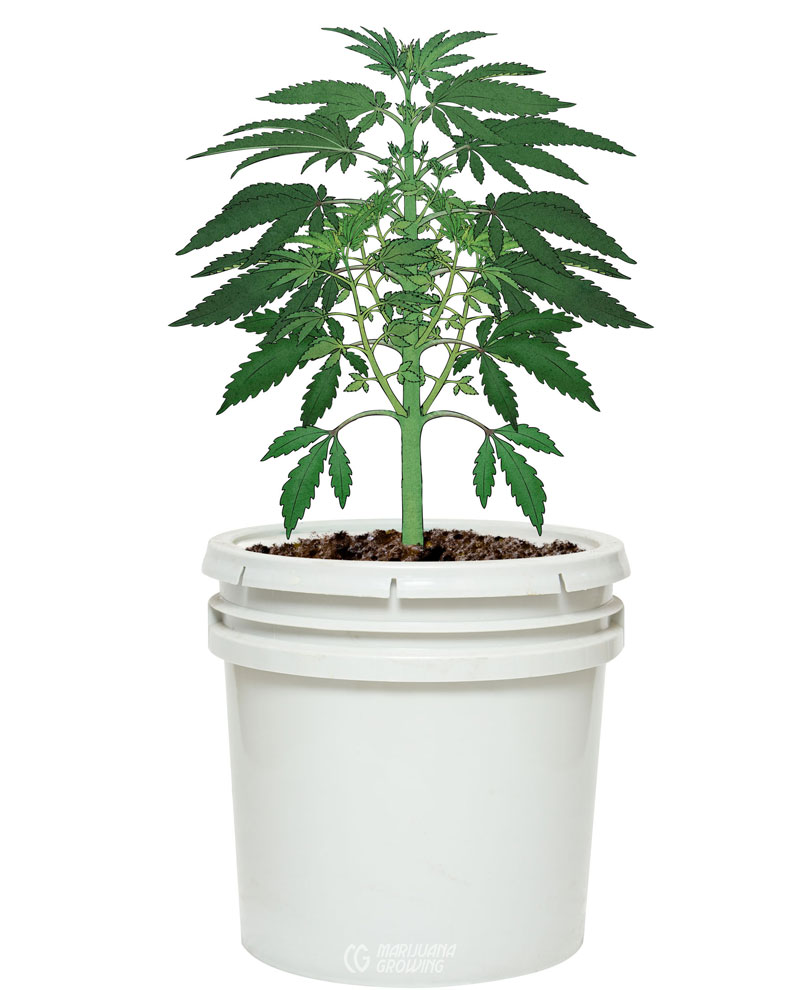
Light
LED + UV
1,000 umol/m2/s
Photoperiod: 12/12 day/night
Intensity: 700 μmols/m2/second
Auto-flower: 20/4 day/night
Intensity: 550 μmols/m2/second
Air
Temperature
Min/Max: 55-80ºF (13-27ºC)
Ideal: 75ºF (24ºC)
Humidity
Min/Max: 40-60%
Ideal: 50%
CO2: 1,400
Water
pH: 5.5-6.5
EC: <50
Irrigation: Plants need 25 ounces (75 cl) or more of water each week. Keep growing medium evenly moist so that roots stay wet but still have enough air to take in nutrients. Continue to monitor water levels carefully to avoid overwatering and underwatering.
Plants may need irrigation less often this week because they are in larger pots.
Nutrients
EC: 2.0-2.4 / PPM: 2,000-2,400
Fertilizer: Switch to your favorite “bloom” nutrients with higher levels of potassium and phosphorus to stimulate bud growth; use per manufacturer’s instructions. Pay special attention to the dosage calendar.
Soil/Substrate
pH:
Soil: 6–6.5
Hydroponics: 5.5
CAUTION:
Stress symptoms will be more evident now and appear in the form of slow growth, yellow and discolored foliage and burned leaf tips. Most often stress is brought on by (1) over-watering, (2) over-fertilization – a build-up of nutrients in the substrate, (3) lack of light, (4) temperatures too hot, cold or fluctuate too much, (5) humidity too high or low, (6) poor drainage. See “Misdiagnosed Disorders” in Chapter Eight, Diseases, Pests & Problems.

Growth Characteristics: The first week of flowering growth, seedlings should be about 14 inches (36 cm) tall. They will recover from transplanting and develop roots and green leafy growth. Stems start to elongate as plants start to prepare to flower.
Diseases and pests may rear their ugly heads now. Inspect foliage and soil surface for signs of the two most common problems, fungus (powdery mildew & gray mold), and spider mites. See Chapter Eight, Diseases, Pests & Problems. Inspect for all the diseases and pests listed in Chapter Eight. Switch to flowering nutrients.
Week Five: Second Week of Flowering

Light
LED + UV
1,000 umol/m2/s
Photoperiod: 12/12 day/night
Intensity: 700 μmols/m2/second
Auto-flower: 20/4 day/night
Intensity: 550 μmols/m2/second
Air
Temperature
Min/Max: 55-80ºF (13-27ºC)
Ideal: 75ºF (24ºC)
Humidity
Min/Max: 40-60%
Ideal: 50%
CO2: 1,400
Water:
pH: 5.5-6.5
EC: <50
Irrigate: Plants need one quart (1 L) or more of water
each week. Avoid overwatering and underwatering.
Nutrients
EC: 2.0-2.4 / PPM: 2,000-2,400
Fertilizer: Use your favorite “bloom” nutrients with higher levels of potassium and phosphorus to stimulate bud growth as per instructions. Add any additives suggested by the company, such as PK 13/14 below. P=potassium and K=phosphorus, 13/14 are the percentages of each.
Add PK 13/14 or a similar roduct. On Friday add PK 13/14 again. This product is packed with more potassium (P) and phosphorus (K) for bigger, denser buds.
Soil/Substrate
pH:
Soil: 6–6.5 pH
Hydroponics: 5.5 pH
Growth Characteristics: The second week of flowering growth seedlings should be about 16 inches (41 cm) tall. They will continue to develop root systems and green leafy growth increases. Fast-growing roots could start to poke out container drainage holes. Stems will elongate more this week, stretching upward.
White, fuzzy, hairlike pistils sticking out of seed bracts should be visible on female plants.
CAUTION:
Stress symptoms will be more evident now and appear in the form of slow growth, yellow and discolored foliage, and burned leaf tips. Control temperature, humidity, and moisture. Flush system and change nutrient solution.
Remove male plants. Check for male flowers.
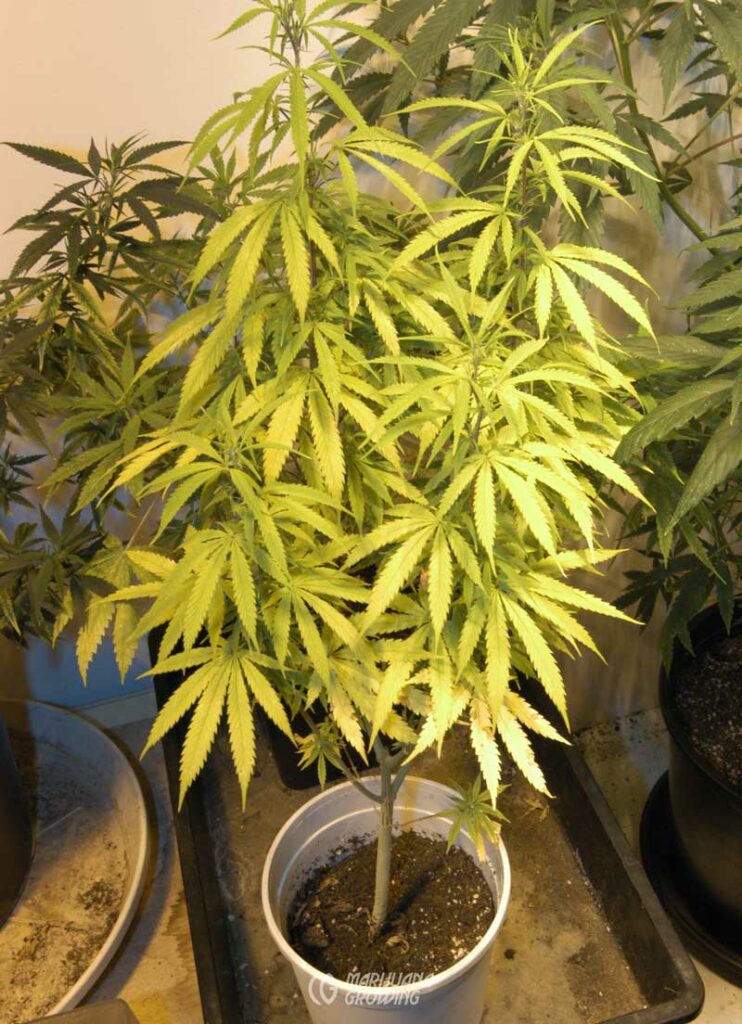
Diseases and pests will continue to become more of a problem if the room is not kept clean. Weak under-fertilized and under-watered plants like this are a target for pests and diseases. Inspect foliage for signs of spider mites and other pests. Check soil surface for signs of fungus gnats.

White pistils on female plants appear now.

Remove all male plants as soon as they are identified.

Male plants will start to show first signs of flowering pollen sacks.

Stems will elongate more this week.
Week Six: Third Week of Flowering

Light
LED + UV
1,000 umol/m2/s
Photoperiod: 12/12 day/night
Intensity: 700 μmols/m2/second
Auto-flower: 20/4 day/night
Intensity: 550 μmols/m2/second
Air
Temperature
Min/Max: 55-80ºF (13-27ºC)
Ideal: 75ºF (24ºC)
Humidity
Min/Max: 40-60%
Ideal: 50%
CO2: 1,400
Water:
pH: 5.5-6.5
EC: <50
Irrigation: Plants need 1.5 quarts (1.5 L) or more of water a week. Keep growing medium moist. Avoid overwatering and underwatering. But if growing in soil, you may need to water every other day or when the soil surface is dry about an inch (3 cm) deep.
Nutrients
EC: 2.0-2.4 / PPM: 2,000-2,400
Fertilizer: Use your favorite “bloom” nutrients with higher levels of potassium and phosphorus to stimulate bud growth as per instructions. Add any additives suggested by the company.
Wednesday add PK 13/14 or a similar product.
Soil/Substrate
pH:
Soil: 6–6.5 pH
Hydroponics: 5.5 pH

Growth Characteristics: The third week of flowering growth seedlings should be about 18 inches (45 cm) tall. They Will continue to develop roots and green leafy growth increases. Stem elongation continues but at a slower rate now. White fuzzy pistils on female plants will multiply and become more and more prominent. Remove plants with male flowers. The California Orange plant in the image was grown in British Columbia, Canada.
Weed out male plants!
Take clones now to pre-grow them for the next 8-week crop.
CAUTION:
Stress symptoms will be more evident now and appear in the form of slow growth, yellow and discolored foliage, and burned leaf tips. Control stress by adjusting the environment to ideal conditions, and flush soil or change hydroponic nutrient solution in reservoirs.
Diseases and pests will continue to become more of a problem if the room is not kept clean. Inspect foliage for spider mites. Check soil surface for signs of fungus gnats. See Chapter Eight, Diseases, Pests & Problems, for control measures.
Week Seven: Fourth Week of Flowering

Light
LED + UV
1,000 umol/m2/s
Photoperiod: 12/12 day/night
Intensity: 700 μmols/m2/second
Auto-flower: 20/4 day/night
Intensity: 550 μmols/m2/second
Air
Temperature
Min/Max: 55-80ºF (13-27ºC)
Ideal: 75ºF (24ºC)
Humidity
Min/Max: 40-60%
Ideal: 50%
CO2: 1,400
Water:
pH: 5.5-6.5
EC: <50
Irrigation: Plants need 2 quarts (2 L) or more of water per week. Keep growing medium evenly moist.
Monitor water levels carefully. Growing medium could start to dry out daily from now on. On Friday, flush plants with 3 times the volume of water as the volume of growing medium to wash out any built-up nitrogen in the growing medium. For example, flush a 3-gallon (11 L) container with 9 gallons (33 L) of water.
Nutrients
EC: 2.0-2.4 / PPM: 2,000-2,400
Fertilizer: Most manufacturers advise to increase fertilizer dosage this week. Use your favorite
“bloom” nutrients with higher levels of potassium and phosphorus to stimulate bud growth as per instructions. Add any additives suggested by the company.
Soil/Substrate
pH:
Soil: 6–6.5 pH
Hydroponics: 5.5 pH

Growth Characteristics: During the fourth week of flowering, seedlings should be about 20 inches (51 cm) tall. They will continue to develop roots but much more energy is put into flower/bud formation. You can see why Big Bud (pictured) is a favorite to grow. Elongation continues but at a very slow rate. Calyxes with pistils continue to develop and buds fill in and growing really starts to get exciting now!
Plant seeds for the next crop.
CAUTION:
Stress symptoms will become apparent now and appear in the form of slow growth, yellow and discolored foliage, and burned leaf tips. Control stress by adjusting the environment to ideal conditions, and flush soil or change hydroponic nutrient solution in reservoirs.
Diseases and pests will become problematic if the room is not kept clean. Inspect foliage for spider mites and other pests. Check soil surface for signs of fungus gnats. See Chapter Eight, Diseases, Pests & Problems for control methods.
Week Eight: Fifth Week of Flowering

Light
LED + UV
1,000 umol/m2/s
Photoperiod: 12/12 day/night
Intensity: 700 μmols/m2/second
Auto-flower: 20/4 day/night
Intensity: 550 μmols/m2/second
Air
Temperature
Min/Max: 55-80ºF (13-27ºC)
Ideal: 75ºF (24ºC)
Humidity
Min/Max: 40-60%
Ideal: 50%
CO2: 1,400
Water:
pH: 5.5-6.5
EC: <50
Irrigation: Plants need 2.5 quarts (2.5 L) or more of water a week. Keep growing medium evenly moist.
Watch water levels carefully and avoid overwatering and underwatering.
Nutrients
EC: 2.0-2.4 / PPM: 2,000-2,400
Fertilizer: Use your favorite “bloom” nutrients with higher levels of potassium and phosphorus to stimulate bud growth as per instructions. Add any additives suggested by the company.
Soil/Substrate
pH:
Soil: 6–6.5 pH
Hydroponics: 5.5 pH

Growth Characteristics: This Nebula female is in the fifth week of flowering, seedlings should be about 22 inches (56 cm) tall. Plants will develop roots but much more energy is put into flower/bud formation. Stem elongation continues but at a very slow rate. Calyxes continue to develop, and buds continue to fill in.

CAUTION:
The unmistakable fragrance of fresh marijuana should start to become very prevalent this week. You will need to take measures to remove or filter it out with a carbon filter.

Carbon filter
Take clones for the next crop.
CAUTION:
Stress symptoms will slow growth, yellow and discolor foliage, and burn leaf tips. See Chapter Eight, Diseases, Pests & Problems, for more information.
Diseases and pests will become problematic if the room is not kept clean. Inspect foliage for spider mites and other pests. See Chapter Eight, Diseases, Pests & Problems, for more details.
Week Nine: Sixth Week of Flowering

Light
LED + UV
1,000 umol/m2/s
Photoperiod: 12/12 day/night
Intensity: 700 μmols/m2/second
Auto-flower: 20/4 day/night
Intensity: 550 μmols/m2/second
Air
Temperature
Min/Max: 55-80ºF (13-27ºC)
Ideal: 75ºF (24ºC)
Humidity
Min/Max: 40-60%
Ideal: 50%
CO2: 1,400
Water:
pH: 5.5-6.5
EC: <50
Irrigation: Plants need 2.5 quarts (2.5 L) or more per week. Keep growing medium evenly moist. Monitor water levels carefully to avoid overwatering and underwatering.
Nutrients
EC: 2.0-2.4 / PPM: 2,000-2,400
Fertilizer: Use your favorite “bloom” nutrients with higher levels of potassium and phosphorus to stimulate bud growth as per instructions. Add any additives suggested by the company.
Soil/Substrate
pH:
Soil: 6–6.5 pH
Hydroponics: 5.5 pH
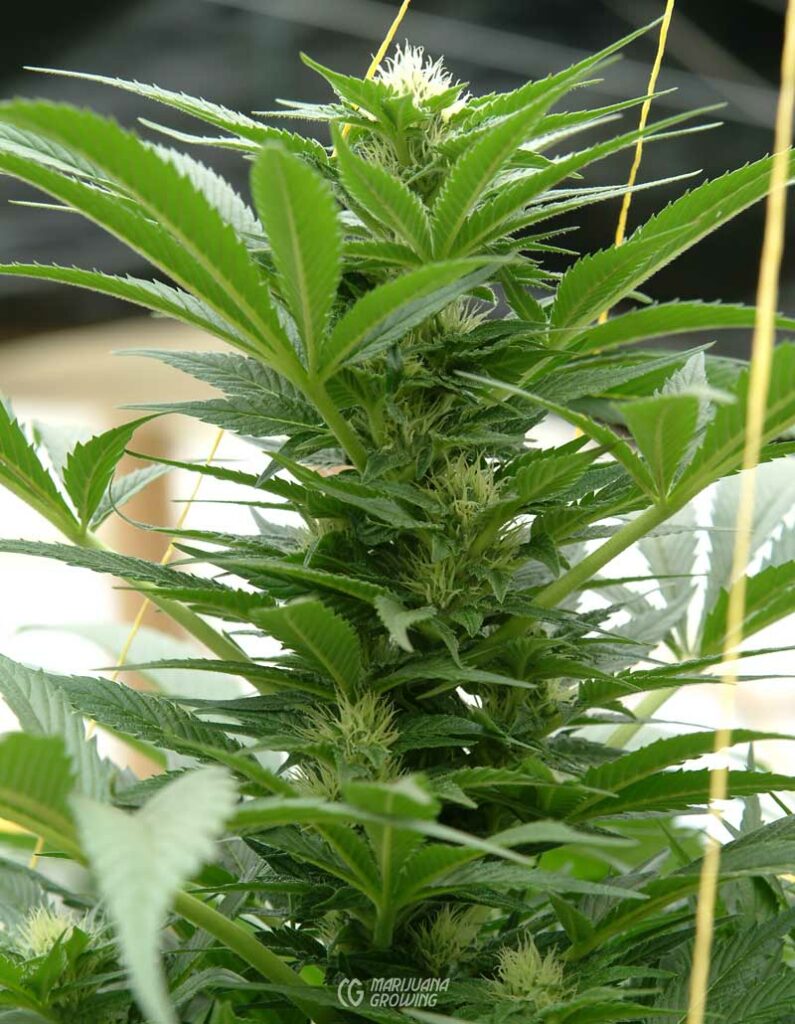
Growth Characteristics: This is the sixth week of flowering growth. Seedlings should be about 22 inches (60 cm) tall. Plants put much energy into flower/bud formation. Stem elongation continues but very, very slowly. Calyxes with white fuzzy pistils continue to develop, and buds start to put on weight. Larger leaves may yellow and discolor.
Remove bottom branches that impair air circulation between plants to guard against fungus. Do not remove, the growth is relatively strong and productive.
CAUTION:
Stress will slow growth, yellow and discolor foliage, and burn leaf tips.

CAUTION:
The unmistakable fragrance of fresh marijuana will be more and more dominant this week. You must remove or filter it out before expelling outdoors.
Diseases and pests will become problematic if the room is not kept clean. Inspect foliage for spider mites and other pests and diseases. Check soil surface for signs of fungus gnats. See Chapter Eight, Diseases, Pests & Problems, for control methods.
Week Ten: Seventh Week of Flowering

Light
LED + UV
1,000 umol/m2/s
Photoperiod: 12/12 day/night
Intensity: 700 μmols/m2/second
Auto-flower: 20/4 day/night
Intensity: 550 μmols/m2/second
Air
Temperature
Min/Max: 55-80ºF (13-27ºC)
Ideal: 75ºF (24ºC)
Humidity
Min/Max: 40-60%
Ideal: 50%
CO2: 1,400
Water:
pH: 5.5-6.5
EC: <50
Irrigation: Plants need 2.5 quarts (2.5 L) or more of water a week. Keep growing medium evenly moist.
Watch water levels carefully to avoid overwatering and underwatering.
Nutrients
EC: 2.0-2.4 / PPM: 2,000-2,400
Fertilizer: Use your favorite “bloom” nutrients with higher levels of potassium and phosphorus to stimulate bud growth as per instructions. Add any additives suggested by the company.
Soil/Substrate
pH:
Soil: 6–6.5 pH
Hydroponics: 5.5 pH

Growth Characteristics: During the seventh week of flowering growth, seedlings should be about 24 inches (61 cm) tall. They put energy into flower/ bud formation. Stem elongation virtually stops. Calyxes continue to develop, and buds really pack on weight; buds start to get hard and plump! Large leaves continue to yellow and discolor. Leaves around buds may show burned tips and become brittle, especially if given high doses of fertilizer.
Stress will slow growth, yellow and discolor foliage, and burn leaf tips.

CAUTION:
The fragrance of fresh marijuana will be very strong this week if growing potent strains. Take measures to remove or filter it out. Check the filter for efficiency.
Diseases and pests will continue if the room is not kept clean. Inspect foliage for spider mites and other pests and diseases. Check soil surface for signs of fungus gnats. Check for bud mold (botrytis) See Chapter Eight, Diseases, Pests & Problems, for control methods.

Stop all spraying this week.
Week Eleven: Eighth Week of Flowering
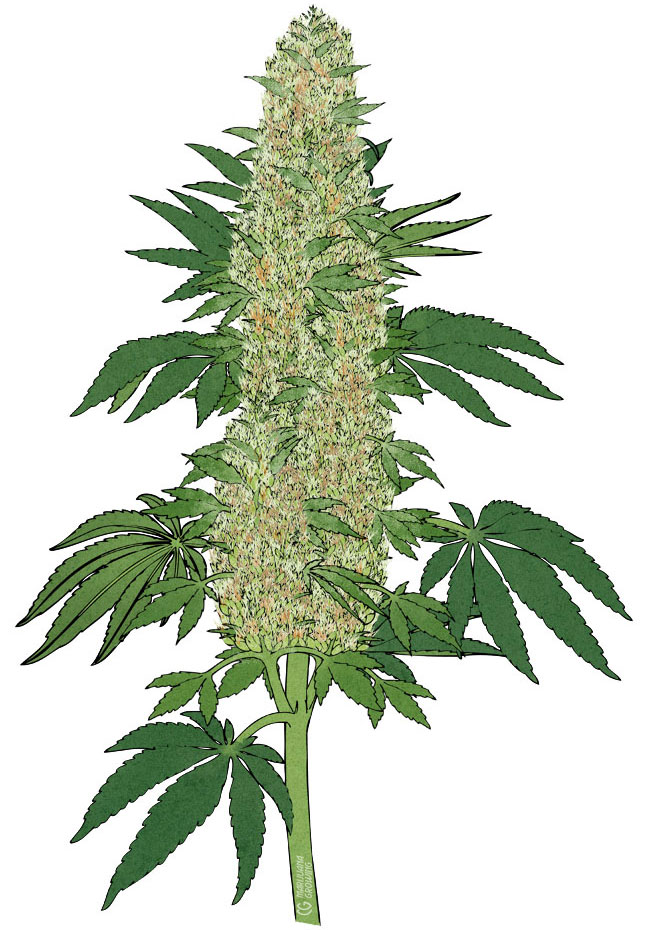
Light
LED + UV
1,000 umol/m2/s
Photoperiod: 12/12 day/night
Intensity: 700 μmols/m2/second
Auto-flower: 20/4 day/night
Intensity: 550 μmols/m2/second
Air
Temperature
Min/Max: 55-80ºF (13-27ºC)
Ideal: 75ºF (24ºC)
Humidity
Min/Max: 40-60%
Ideal: 50%
CO2: 1,400
Water:
pH: 5.5-6.5
EC: <50
Irrigation: Plants need progressively more water, 2.5 quarts (2.5 L) or more per week. Stop watering 3 days before harvest to start removing water from growing medium, and plants will dry faster.
On Monday, flush plants with 3 times the volume of water as the volume of growing medium to wash out any built-up nitrogen in the growing medium. For example, flush a 1-gallon (4 L) container with 3 gallons (12 L) of water. You might want to use a “clearing agent” such as Final Flush.
Nutrients

EC: 2.0-2.4 / PPM: 2,000-2,400
Fertilizer: Stop fertilizing this week and apply plain water to wash out built-up fertilizer from growing medium. Some growers stop fertilizing 10 days before harvest to allow plants to use all the fertilizer so that buds, when smoked, do not taste like fertilizer.
Soil/Substrate
pH:
Soil: 6–6.5 pH
Hydroponics: 5.5 pH

Growth Characteristics: This is harvest week! During the eighth week of flowering plants should be about 24 inches (61 cm) tall. They will continue to develop roots but much more energy is put into flower/bud formation. Calyxes with pistils continue to develop, and buds put on more and more weight until harvest. Large leaves will be yellow, and smaller leaves could be discolored with dark tips.
CAUTION:
Stress symptoms will become very apparent now, appearing in the form of slow growth, yellow and discolored foliage, and burned leaf tips.
Diseases and pests: Cut out any bud mold you find. Nothing can be done for latent spider mites and other pests. They will bunch up at the top of buds or escape out the end of the drying line.

CAUTION:
The fragrance of fresh marijuana will be the strongest this week if growing potent strains. Take measures to remove or filter out fragrance.
Week Twelve: Harvest
Light
Photoperiod: 12 hours day, 12 hours night
Intensity: 1000 μmols/m2/second
Auto-flower: 20 hours day, 4 hours night
Intensity: 550 μmols/m2/second
Air
Temperature
Min/Max: 55-70ºF (13-21ºC)
Ideal: 60ºF (15.5ºC)
Humidity
Day: 50%
Night: 50% night

Cut plants at base to harvest. Remove individual branches afterward to manicure.

Beautiful crop started indoors is ready to harvest.

Peter from the Cannabis College (1997) in Amsterdam inspects for peak ripeness.

Harvesting in Morocco 1998.

Good friend Xus (RIP) harvesting crop in 1999.
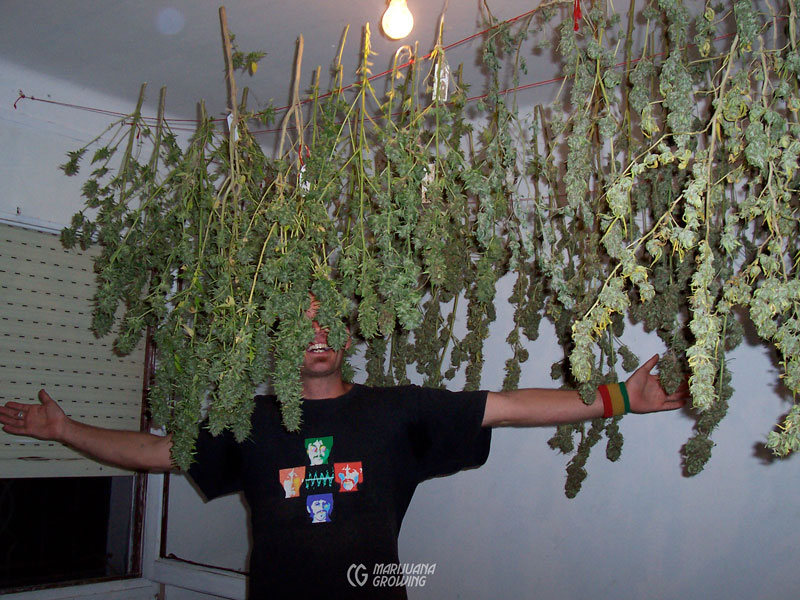
Experience the joy of your harvest.

A Mexican friend poses in a “lucha libre” mask with an illegalharvest in the early 2000s.

